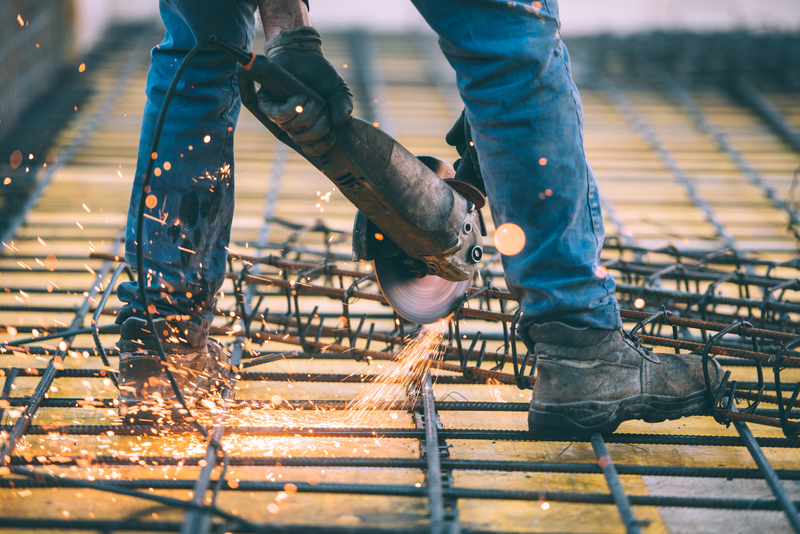
by Damien Therrio | Aug 28, 2018 | Construction Safety
Tools can be hazardous objects when they are being misused. Though someone may be trained to use tools and may take the necessary precautions when using dangerous tools, people often make mistakes. Unfortunately, these mistakes can be fatal or may create life-altering circumstances for a person. There are numerous ways that you can ensure that people are safe around your tools and equipment. These methods are sometimes overlooked, forgotten, or ignored but may be the difference between life and death for anyone in the vicinity of dangerous tools.
Training
One of the primary reasons that people get injured from using tools is because they are not adequately trained on how to handle dangerous tools. Learning how to use hazardous tools provides a person with the knowledge of what they can and cannot do around these tools. Through proper instruction, a person can learn the necessary precautions that they will need to take before operating dangerous equipment. Tool manufacturers commonly offer instruction manuals and warning labels that people should become acquainted with before touching any equipment.
Transportation Cases
Transportation cases create a safe environment for tools to be stored during the times where they are not being used or are being moved between locations. Many injuries come from the improper handling of tools that are loose. However, transportation cases reduce these injuries by eliminating the event where a tool is loose and may not be seen before it is too late. There are a variety of transportation cases, with different sizes and different uses. Some cases, such as rack boxes, are designed for storage on the racks of moving vehicles. Your choice in transportation casing will depend on your personal tool usage and storage needs.
Maintenance
A faulty tool can be a fatal tool. Proper tool maintenance is a necessity when ensuring tool and equipment safety. Through routine checks and inspections, you will be alert to any equipment malfunctions that can cause harm. If you find that a tool is faulty, or not working as expected, make sure to terminate the usage of the tool and have it repaired. Sometimes a tool cannot be fixed and may need to be replaced altogether.
Tools can be inherently dangerous to use, but through preparation and precaution, you can develop a safe and effective worksite. These three basic steps will allow you to create a much safer work environment.
References:
Vivid Learning Systems
All Cases
Reliable Plant
Fluent Conveyors

by Damien Therrio | Aug 18, 2018 | Construction Administration
Since even the smallest construction projects involve numerous people and details, it’s important for managers to make full use of the various tools and technology available to them. From keeping employees safe to paying bills, these and other details are encountered in a typical day. Nearly three million nonfatal work-related accidents were reported to the federal government in 2012 alone, and nearly half of those required the injured employee to miss at least one day of work (source). To learn how to effectively manage these tasks, here are five ways you can properly manage even the busiest construction site.
Preventing Accidents and Injuries
When someone goes to work, the last thing that they expect to come home with is an injury. According to one personal injury lawyer, some jobs are more dangerous than others, and the risk of an injury for an employee is higher. However, if a site is properly managed, the chances of injuries occurring is very low. Eric Ramos suggests that proper site management and injury prevention includes (among other measures) always maintain safety and building codes, and ensure workers are using necessary safety equipment such as protective helmets, goggles, and harnesses. In addition to this, make sure anyone operating equipment has been trained and certified to do so since a failure in this area could lead to serious penalties from OSHA.
Inspect the Site Daily
As explained in this article, most construction contracts require daily inspections, make this a top priority. By doing so, you can inspect materials and equipment for damage, and also make sure nothing has been stolen. Make sure you have everything you need to protect your equipment. Safety mats are essential for extending your equipment life and should be on the ground and ready for your machines. Remember, an ounce of prevention is worth a pound of cure
Coordinate Delivery Schedules
To keep a job running on schedule and on budget, coordinate delivery schedules of materials, tools, and equipment with various tradespeople on the site, such as electricians, plumbers, HVAC technicians, and others. By doing so, you’ll avoid unnecessary delays.
Project Management Software
To take some stress off of yourself and those working for you, always utilize state-of-the-art project management software. Very beneficial to small companies, this software can continuously track the progress of the project, letting you know if you’re under or over your budget. And since this software usually has reactive technology, it can constantly update figures based on what’s been done, making its data very accurate and reliable.
Monitor Inspections and Licensing
As a project progresses, various inspections are performed by local, state, and federal agencies. Along with this, new types of licensing are often required with each new phase of a project. Therefore, always monitor inspections and licensing carefully, since failing to do so can sometimes lead to fines or even the possibility of losing the contract, as talked about in this article.
By incorporating these steps into your worksite management plan, chances are you will have a project that comes in under budget, on time, and produces a very satisfied client.
Have more questions about how to manage your construction site, or are looking for the best in commercial construction? Contact us now, and let our experience work for you!



Recent Comments